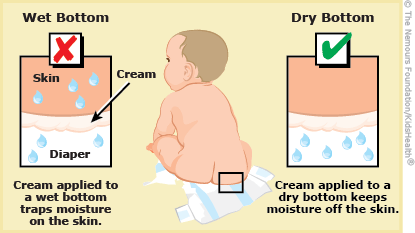To treat diaper rash, keep the baby’s skin clean and dry. Apply a diaper rash cream or ointment.
Diaper rash can cause discomfort and distress for babies. It often results from prolonged exposure to wet or dirty diapers. Keeping the baby’s skin dry is crucial. Change diapers frequently to prevent moisture buildup. Clean the diaper area gently with water and mild soap.
Avoid using wipes with alcohol or fragrance, as they can irritate the skin. After cleaning, let the area air-dry or gently pat it dry with a soft cloth. Applying a zinc oxide-based cream helps protect the skin and promote healing. If the rash persists or worsens, consult a pediatrician for further advice. Proper care ensures your baby remains comfortable and rash-free.
Identifying Diaper Rash
Diaper rash is common in babies and can cause discomfort. Identifying the rash early can help in treating it effectively.
Common Symptoms
Knowing the symptoms of diaper rash can help you act quickly. Here are some common signs:
- Redness and swelling: The affected area appears red and swollen.
- Blisters or sores: Small blisters or sores may form.
- Itching and discomfort: Your baby may seem more irritable.
- Dry or peeling skin: The skin may become dry and start to peel.
When To See A Doctor
Most diaper rashes can be treated at home. But sometimes, you need to see a doctor. Consider medical advice if:
- The rash doesn’t improve after a few days.
- Blisters, pus, or open sores appear.
- Your baby has a fever along with the rash.
- The rash spreads beyond the diaper area.

Credit: www.pinterest.com
Causes Of Diaper Rash
Diaper rash can make babies uncomfortable and fussy. Understanding the causes helps in preventing and treating it effectively. Below are some common causes of diaper rash.
Irritation From Stool And Urine
Babies wear diapers all day. Wet diapers can cause skin irritation. Stool and urine have bacteria and chemicals. These can irritate a baby’s skin quickly. Change diapers often to reduce irritation.
Chafing And Rubbing
Diapers can rub against a baby’s skin. Tight diapers or rough materials increase this friction. This leads to chafing. Chafing causes redness and soreness on the skin. Make sure the diaper fits well but is not too tight.
| Cause | Description |
|---|---|
| Irritation from Stool and Urine | Wet diapers can irritate the baby’s skin quickly. |
| Chafing and Rubbing | Tight or rough diapers can rub the baby’s skin. |
- Change diapers frequently.
- Use soft and well-fitting diapers.
- Keep the diaper area clean and dry.
- Check the diaper every 2 hours.
- Use a barrier cream for protection.
- Let the baby go diaper-free for a while each day.
Preventive Measures
Preventing diaper rash is easier than treating it. Follow these simple steps to keep your baby’s skin healthy and rash-free.
Frequent Diaper Changes
Changing diapers often is crucial. Wet or dirty diapers irritate the skin. Check diapers every two hours. Change them immediately if they are soiled. Nighttime diapers should also be checked and changed as needed.
Proper Cleaning Techniques
Cleaning your baby’s diaper area correctly is essential. Use warm water and a soft cloth. Avoid using harsh soaps or wipes with alcohol. Pat the area dry gently. Do not rub, as this can irritate the skin.
| Do’s | Don’ts |
|---|---|
| Use warm water | Use hot water |
| Pat dry gently | Rub the skin |
| Check frequently | Leave diapers on too long |
Following these preventive measures can greatly reduce the risk of diaper rash. Always prioritize your baby’s comfort and hygiene.

Credit: www.youtube.com
Home Remedies
Diaper rash is a common issue for babies. Parents often seek effective home remedies to ease their baby’s discomfort. These remedies are natural and easy to apply. They can help soothe the baby’s skin and promote healing.
Oatmeal Baths
Oatmeal baths are a gentle way to treat diaper rash. Oatmeal soothes the skin and reduces inflammation.
- Fill the bathtub with lukewarm water.
- Add a cup of finely ground oatmeal to the water.
- Stir the water until the oatmeal is fully dissolved.
- Place your baby in the bath for 10-15 minutes.
- Gently pat your baby dry with a soft towel.
Repeat this process daily for best results. Ensure the oatmeal is colloidal for easy dissolution.
Coconut Oil Application
Coconut oil is a natural remedy for diaper rash. It has anti-fungal and anti-bacterial properties that help heal the skin.
- Clean your baby’s bottom with warm water.
- Pat the area dry with a soft cloth.
- Take a small amount of coconut oil in your hand.
- Gently apply the coconut oil to the affected area.
- Allow the skin to absorb the oil before putting on a new diaper.
Use virgin coconut oil for the best results. Apply it several times a day until the rash improves.
Over-the-counter Treatments
Diaper rash is a common issue for babies. Over-the-counter treatments can help soothe and heal the irritated skin. These treatments are easily accessible and effective. Here, we’ll discuss two main types: diaper rash creams and antifungal ointments.
Diaper Rash Creams
Diaper rash creams are designed to protect and heal a baby’s skin. They usually contain zinc oxide, which creates a barrier on the skin. This barrier helps to keep moisture away from the rash. Some popular diaper rash creams include:
- Desitin
- Boudreaux’s Butt Paste
- Aquaphor Baby Healing Ointment
Apply a thin layer of cream to the affected area. Do this during each diaper change. Make sure the skin is clean and dry before application.
Antifungal Ointments
If the diaper rash is caused by a yeast infection, antifungal ointments can help. These ointments kill the yeast and reduce the rash. Common antifungal ointments include:
- Clotrimazole
- Nystatin
Apply a small amount of the ointment to the rash. Use it as directed on the package. Continue use until the rash clears up completely.
| Product | Type | Usage |
|---|---|---|
| Desitin | Diaper Rash Cream | Each diaper change |
| Boudreaux’s Butt Paste | Diaper Rash Cream | Each diaper change |
| Clotrimazole | Antifungal Ointment | As directed |
| Nystatin | Antifungal Ointment | As directed |
Choose the treatment that best fits the baby’s needs. Always consult a pediatrician if unsure.

Credit: kidshealth.org
Natural Alternatives
Diaper rash can be painful for babies. Natural alternatives often work wonders. Here are some effective, safe, and natural options.
Aloe Vera Gel
Aloe Vera Gel is a soothing remedy for diaper rash. Its anti-inflammatory properties help reduce redness and irritation.
- Apply a thin layer of aloe vera gel on the rash.
- Let it air dry before putting on a new diaper.
- Use pure aloe vera gel for the best results.
Breast Milk
Did you know breast milk can treat diaper rash? It’s a natural antiseptic and anti-inflammatory.
- Express a small amount of breast milk.
- Apply it gently to the affected area.
- Allow it to air dry before diapering.
Repeat this process until the rash improves.
When To Consult A Pediatrician
Diaper rash in babies can be distressing for both parents and infants. While most diaper rashes can be treated at home, there are instances where a consultation with a pediatrician becomes necessary. Knowing when to seek medical advice can help prevent complications and ensure your baby’s comfort and health.
Persistent Rash
A diaper rash that lasts more than a few days despite home treatment needs attention. This might indicate an underlying issue that requires medical intervention. Persistent diaper rash can cause significant discomfort for your baby. It can also lead to more severe skin problems.
If the rash does not improve with standard treatments like frequent diaper changes, use of diaper rash creams, and allowing the baby’s skin to breathe, it’s time to consult a pediatrician. They can provide a proper diagnosis and recommend stronger or prescription treatments.
Signs Of Infection
Be alert for signs of infection in your baby’s diaper rash. Infections need prompt medical treatment to avoid spreading and worsening.
| Signs | Description |
|---|---|
| Fever | If your baby develops a fever, it can indicate an infection. |
| Blisters | Blisters on the diaper area suggest a bacterial or fungal infection. |
| Pus | Presence of pus or fluid-filled bumps is a clear sign of infection. |
| Spreading Rash | If the rash spreads beyond the diaper area, seek medical help. |
Parents should also watch out for behavioral changes in their baby. Increased fussiness, crying during diaper changes, or reduced appetite can be signs of discomfort or infection. Consulting a pediatrician ensures proper care and a speedy recovery for your baby.
Tips For Long-term Prevention
Diaper rash can be painful for babies and stressful for parents. Long-term prevention is key to keeping your baby’s skin healthy and rash-free. Here are some effective tips to help you prevent diaper rash in the long run.
Choosing The Right Diapers
Choosing the correct diaper can make a big difference. Look for diapers that are:
- Absorbent: High absorbency keeps moisture away from the skin.
- Breathable: Breathable diapers allow air to circulate.
- Soft: Soft materials reduce friction and irritation.
- Hypoallergenic: Hypoallergenic diapers are gentle on sensitive skin.
Consider using cloth diapers. Cloth diapers are often more breathable and gentle. Ensure they are washed with mild detergent.
Maintaining Dry Skin
Keeping your baby’s skin dry is crucial. Follow these steps to maintain dry skin:
- Frequent Diaper Changes: Change diapers frequently to avoid prolonged moisture.
- Use Barrier Creams: Apply a thin layer of barrier cream with each change.
- Allow Air Time: Let your baby go diaper-free for short periods.
- Pat Dry: After cleaning, pat the area dry instead of rubbing.
| Tip | Action |
|---|---|
| Frequent Diaper Changes | Change every 2-3 hours |
| Use Barrier Creams | Apply with each change |
| Allow Air Time | Diaper-free for 10-15 minutes |
| Pat Dry | Use a soft cloth |
Keeping your baby’s skin clean is also important. Use gentle, unscented wipes or a soft cloth with water. Avoid using harsh soaps or products with alcohol. These can dry out and irritate your baby’s skin.
Frequently Asked Questions
How To Get Rid Of Diaper Rash Quickly?
Change diapers frequently to keep the area dry. Apply a thick layer of diaper rash cream. Clean gently with warm water. Let the skin air out. Use mild, fragrance-free wipes.
Is Diaper Rash Painful For Babies?
Yes, diaper rash can be painful for babies. It causes redness, swelling, and discomfort. Treat it promptly.
Is Vaseline Good For A Diaper Rash?
Yes, Vaseline helps soothe and protect diaper rash. It forms a barrier, preventing further irritation. Always clean the area before applying.
What Not To Do When Baby Has Diaper Rash?
Avoid using baby wipes with alcohol. Don’t rub the area harshly. Refrain from using tight diapers. Skip scented products. Don’t ignore persistent rashes; consult a doctor.
What Causes Diaper Rash In Babies?
Diaper rash is caused by prolonged exposure to wet or soiled diapers, friction, and sensitive skin.
Conclusion
Caring for your baby’s skin can prevent diaper rash. Always keep the area clean and dry. Use gentle products designed for babies. Regularly change diapers to minimize irritation. Consult your pediatrician if the rash persists. These simple steps can ensure your baby stays comfortable and happy.

